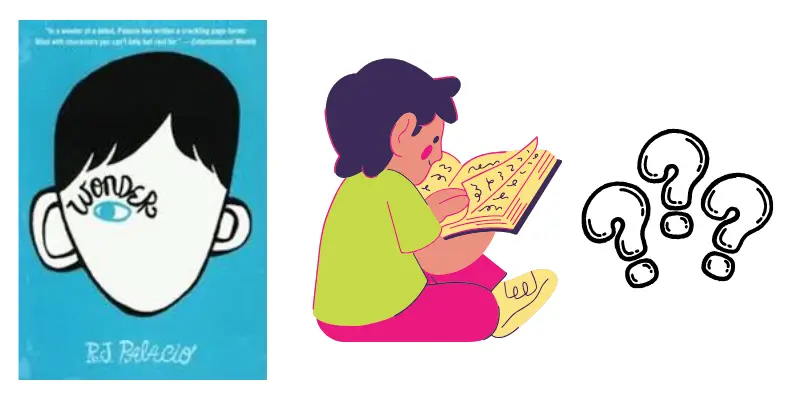Wonder Book Reading Level: Is R.J. Palacio’s Story Right for Your Child?
Updated: 07 Jul 2025
125
Wonder by R.J. Palacio is more than just a book — it’s an emotional journey that teaches kindness, empathy, and courage through the eyes of a boy with a facial difference. While the story is touching and powerful, many parents and teachers often wonder:
Is Wonder the right fit for my child’s reading level and emotional maturity?
This guide will walk you through the reading level, age suitability, and themes in Wonder, helping you decide if your child is ready for this life-changing book.
Table of Contents
What is the Reading Level of Wonder?
The reading level of Wonder is designed for upper elementary and middle-grade readers.

Here’s a quick breakdown:
- Lexile Measure: 790L
- AR (Accelerated Reader) Level: 4.8
- Recommended Grade Level: 4th to 6th grade
What does a 790L Lexile mean?
It means the book is slightly above average difficulty for a 10-year-old reader. Vocabulary and sentence structure are age-appropriate but may need guidance for struggling readers.
Tip:
If your child comfortably reads books like Charlotte’s Web (680L) or Because of Winn-Dixie (610L), then Wonder is likely the next step up in challenge.
What Age is Wonder Book Appropriate For?
Wonder is generally recommended for ages 9 to 12, but it isn’t just about reading words—it’s also about understanding the emotional depth of the story.

Here’s a quick guide:
| Age | Grade | Suitable? |
|---|---|---|
| 8 | 3rd | Possibly, with guidance |
| 9–10 | 4th–5th | Yes |
| 11–12 | 6th | Absolutely |
But reading level isn’t everything.
Parents should consider:
- Is my child ready to discuss bullying, peer pressure, and medical conditions?
- Will the book’s emotional scenes be too overwhelming or a great conversation starter?
Example:
One parent shared how reading Wonder together helped her 10-year-old understand a classmate’s experience with hearing loss. The book opened up honest, heartfelt discussions.
Helpful Tip:
If your child is younger but curious, try reading it together aloud. That way, you can pause and talk through the more emotional moments.
What Themes Make Wonder a Valuable Read?
One reason Wonder connects with readers of all ages is its powerful themes. These are not just helpful in literacy development but also in emotional learning.
Here are the key themes explored in Wonder:
Kindness and Empathy
The famous quote from the book — “When given the choice between being right and being kind, choose kind” — sets the tone. Children learn how small acts of kindness can change someone’s day.
Acceptance and Inclusion
August Pullman (Auggie), the main character, was born with a facial difference. The story gently teaches children that people who look different deserve just as much respect, friendship, and inclusion.
Courage and Resilience
Auggie’s journey through school is filled with challenges. Readers see how he stands tall despite bullying and isolation — a message that inspires kids to stay strong, even when things get hard.
Family and Friendship
The support system around Auggie — his sister, parents, and true friends — shows the importance of love, understanding, and being there for each other.
Classroom tip:
Many teachers use Wonder to spark discussions about empathy and bullying prevention during kindness weeks or social-emotional learning (SEL) lessons.
Real-life example:
Some schools even host “Choose Kind” campaigns inspired by the book — encouraging students to do something kind every day.
Is Wonder a Good Book for School and Class Discussions?
Yes, Wonder is an excellent book for classroom reading in upper elementary or early middle school. It checks all the boxes for educational value.
Here’s why it works so well in school:
- Age-appropriate reading level (grades 4–6)
- Broad discussion points (bullying, empathy, acceptance)
- Cross-curricular value – supports language arts, ethics, and social-emotional learning
- High engagement – even reluctant readers connect with Auggie’s story
Common ways teachers use Wonder:

- Read-aloud sessions followed by group discussions
- Character analysis (Auggie, Via, Jack Will, Julian)
- Journal prompts about kindness or peer relationships
- Debates or creative projects based on different character perspectives
Teacher tip:
Pair Wonder with nonfiction texts about facial differences, bullying, or disabilities to deepen students’ understanding and empathy.
Final Recommendation: Is Wonder the Right Choice for Your Child or Student?
Absolutely! Wonder isn’t just easy to read — it’s deeply moving and filled with lessons that stay with kids long after they finish the last page.
Here’s why it’s a great fit:
✅ Appropriate for ages 9–12
✅ Ideal for 4th to 6th grade readers
✅ Simple language but rich message
✅ Encourages social awareness and kindness
✅ Perfect for group discussions, book clubs, and classroom read-alouds
If your child is just starting chapter books or is ready to move from lighter stories to deeper topics, Wonder is a perfect stepping stone.
Pro tip for parents:
Read it together. Many parents say that reading Wonder alongside their child opened up meaningful conversations about self-image, bullying, and kindness.
Pro tip for teachers:
Consider using the Wonder companion book “365 Days of Wonder” for daily quotes and writing prompts — it’s great for building a kind classroom culture.
FAQs
1. What grade level is Wonder by R.J. Palacio for?
It’s most suitable for grades 4 to 6, though older students can also enjoy and benefit from it.
2. What is the Lexile level of Wonder?
The Lexile level is 790L, which fits upper elementary and early middle school readers.
3. What age group should read Wonder?
Ages 9–12 is the ideal range, but even teens and adults find value in the story.
4. Is Wonder appropriate for school?
Yes! It’s often part of classroom reading because of its accessible language and strong moral themes.
5. Can Wonder help teach empathy?
Definitely. It’s one of the most effective books for helping children understand kindness, inclusion, and courage.
Please Write Your Comments